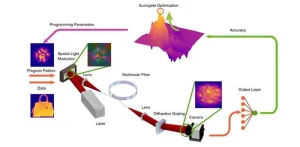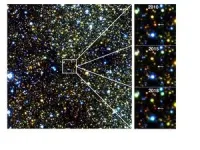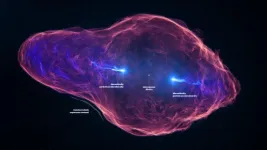(Press-News.org) Current artificial intelligence models utilize billions of trainable parameters to achieve challenging tasks. However, this large number of parameters comes with a hefty cost. Training and deploying these huge models require immense memory space and computing capability that can only be provided by hangar-sized data centers in processes that consume energy equivalent to the electricity needs of midsized cities. The research community is presently making efforts to rethink both the related computing hardware and the machine learning algorithms to sustainably keep the development of artificial intelligence at its current pace.
Optical implementation of neural network architectures is a promising avenue because of the low power implementation of the connections between the units. New research reported in Advanced Photonics combines light propagation inside multimode fibers with a small number of digitally programmable parameters and achieves the same performance on image classification tasks with fully digital systems with more than 100 times more programmable parameters. This computational framework streamlines the memory requirement and reduces the need for energy-intensive digital processes, while achieving the same level of accuracy in a variety of machine learning tasks.
The heart of this groundbreaking work, led by Professors Demetri Psaltis and Christophe Moser of EPFL (Swiss Federal Institute of Technology in Lausanne), lies in the precise control of ultrashort pulses within multimode fibers through a technique known as wavefront shaping. This allows for the implementation of nonlinear optical computations with microwatts of average optical power, reaching a crucial step in realizing the potential of optical neural networks. "In this study, we found out that with a small group of parameters, we can select a specific set of model weights from the weight bank that optics provides and employ it for the aimed computing task. This way, we used naturally occurring phenomena as a computing hardware without going into the trouble of manufacturing and operating a device specialized for this purpose," states Ilker Oguz, lead co-author of the work.
This result marks a significant stride towards addressing the challenges posed by the escalating demand for larger machine learning models. By harnessing the computational power of light propagation through multimode fibers, the researchers have paved the way for low-energy, highly efficient hardware solutions in artificial intelligence. As showcased in the reported nonlinear optics experiment, this computational framework can also be put to use for efficiently programming different high-dimensional, nonlinear phenomena for performing machine learning tasks and can offer a transformative solution to the resource-intensive nature of current AI models.
For details, see the Gold Open Access article by Oguz et al., “Programming nonlinear propagation for efficient optical learning machines,” Adv. Photon. 6(1) 016002 (2024), doi 10.1117/1.AP.6.1.016002.
END
Programming light propagation creates highly efficient neural networks
A new optical neural network architecture achieves nonlinear optical computation by using wavefront shaping to precisely control the propagation of ultrashort pulses in multimode fibers
2024-01-25
ELSE PRESS RELEASES FROM THIS DATE:
Advincula earns prestigious NAI fellow honor
2024-01-25
Rigoberto “Gobet” Advincula has been awarded one of the highest honors of his profession.
Advincula, the University of Tennessee-Oak Ridge National Laboratory Governor’s Chair of Advanced and Nanostructured Materials, has been elected National Academy of Inventors (NAI) Fellow.
Advincula is a leader in the polymer field with inventions and many publications in polymer nanocomposites, graphene nanomaterials, polymer layered films, and coatings. He has been granted 14 US patents and has 21 published filings related to graphene nanomaterials, solid-state device fabrication, smart coatings and films, ...
Sweat-analyzing temporary tattoo research funded in NSF grant to UMass Amherst researcher
2024-01-25
AMHERST – University of Massachusetts Amherst researchers have received an award to develop a new type of sweat monitor that can be applied to the skin just like a temporary tattoo and assess the molecules present, such as cortisol. The tattoos will ultimately give individuals better insight into their health and serve as a tool for researchers to discover new early indications of diseases.
“There are a lot of vital biomolecules that are present in sweat that we need to measure to really understand overall human performance and correlation to different ...
Simulations show how HIV sneaks into the nucleus of the cell
2024-01-25
Because viruses have to hijack someone else’s cell to replicate, they’ve gotten very good at it—inventing all sorts of tricks.
A new study from two University of Chicago scientists has revealed how HIV squirms its way into the nucleus as it invades a cell.
According to their models, the HIV capsid, which is cone-shaped, points its smaller end into the pores of the nucleus and then ratchets itself in. Once the pore is open enough, the capsid is elastic enough to squeeze through. Importantly, the scientists ...
White House rule dramatically deregulated wetlands, streams and drinking water
2024-01-25
The 1972 Clean Water Act protects the "waters of the United States" but does not precisely define which streams and wetlands this phrase covers, leaving it to presidential administrations, regulators, and courts to decide. As a result, the exact coverage of Clean Water Act rules is difficult to estimate.
New research led by a team at the University of California, Berkeley, used machine learning to more accurately predict which waterways are protected by the Act. The analysis found that a 2020 Trump administration rule removed Clean Water Act ...
How an ant invasion led to lions eating fewer zebra in a Kenyan ecosystem
2024-01-25
The invasion of non-native species can sometimes lead to large and unexpected ecosystem shifts, as Douglas Kamaru and colleagues demonstrate in a unique, careful study that traces the links between big-headed ants, acacia trees, elephants, lions, zebras, and buffalo at a Kenyan conservancy. The invasive big-headed ant species disrupted a mutualism between native ants and the region’s thorny acacia trees, in which the native ants protected the trees from grazers in exchange for a place to live. Through a combination of observations, experimental plots, and animal tracking at Ol Pejeta Conservancy, Kamaru et al. followed the ecosystem chain reaction prompted by this disruption. ...
Total organic carbon concentrations measured over Canadian oil sands reveal huge underestimate of emissions
2024-01-25
New measurements of total gaseous organic carbon concentrations in the air over the Athabasca oil sands in Canada suggest that traditional methods of estimating this pollution can severely underestimate emissions, according to an analysis by Megan He and colleagues. Using aircraft-based measurements, He et al. conclude that the total gaseous organic carbon emissions from oil sands operations exceed industry-reported values by 1900% to over 6300% across the studied facilities. “Measured facility-wide emissions represented approximately 1% of extracted petroleum, resulting in total organic ...
Machine learning model identifies waters protected under different interpretations of the U.S. Clean Water Act
2024-01-25
The U.S. Clean Water Act is a critically important part of federal water quality regulation, but the act does not define the exact waters that fall under its jurisdiction. Now, Simon Greenhill and colleagues have developed a machine learning model that helps to clarify which waters are protected from pollution under the United States’ Clean Water Act, and how recent rule changes affect protection. The model demonstrates that the waters protected under the act differ substantially depending on whether the act’s regulations follow a 2006 U.S. Supreme Court ruling or a 2020 White House rule. Under the 2006 Rapanos Supreme Court ruling, the model suggests that the Clean ...
Gamma ray observations of a microquasar demonstrate electron shock acceleration
2024-01-25
Observations of gamma rays, emitted by relativistic jets in a microquasar system, demonstrate the acceleration of electrons by a shock front, reports a new study. The microquasar SS 433 is a binary system made up of a compact object, probably a black hole, and a supergiant star. The black hole pulls material off the star and ejects plasma jets, which move at close to the speed of light. The High Energy Stereoscopic System (H.E.S.S.) is an array of five telescopes in Namibia that observe gamma rays. The H.E.S.S. ...
Astrophysical jet caught in a “speed trap”
2024-01-25
The science fiction author Arthur C. Clarke selected his own seven wonders of the world in a BBC television series in 1997. The only astronomical object he included was SS 433. It had attracted attention already in the late 1970s due to its X-ray emission and was later discovered to be at the center of a gas nebula that is dubbed the manatee nebula due to its unique shape resembling these aquatic mammals.
SS 433 is a binary star system in which a black hole, with a mass approximately ten times that of the Sun, and a star, with a similar mass but occupying a much larger volume, orbit each other with ...
Experts call for major shift in international decision-making to tackle ‘devastating’ impact of urban expansion and avoid ‘planetary catastrophe’
2024-01-25
Leading scientists are today calling for an urgent step change in global governance to save the future of worldwide cities and the planet at large.
Cities are growing at an unprecedented rate, putting overwhelming pressures on exploited land, scarce resources, and fragile ecosystems. The bold proposals, led by experts from the Universities of Bristol, Oxford and Yale, are set out in a Science journal article, proposing a new global advisory system to address the alarming impacts of urban expansion. This system would fulfil a similar function as the Intergovernmental ...
LAST 30 PRESS RELEASES:
Scientists trace microplastics in fertilizer from fields to the beach
The Lancet Obstetrics, Gynecology, & Women’s Health: Taking paracetamol during pregnancy does not increase risk of autism, ADHD or intellectual disabilities, confirms new gold-standard evidence review
Taking paracetamol during pregnancy does not increase risk of autism, ADHD or intellectual disabilities
Harm reduction vending machines in New York State expand access to overdose treatment and drug test strips, UB studies confirm
University of Phoenix releases white paper on Credit for Prior Learning as a catalyst for internal mobility and retention
Canada losing track of salmon health as climate and industrial threats mount
Molecular sieve-confined Pt-FeOx catalysts achieve highly efficient reversible hydrogen cycle of methylcyclohexane-toluene
Investment in farm productivity tools key to reducing greenhouse gas
New review highlights electrochemical pathways to recover uranium from wastewater and seawater
Hidden pollutants in shale gas development raise environmental concerns, new review finds
Discarded cigarette butts transformed into high performance energy storage materials
Researchers highlight role of alternative RNA splicing in schizophrenia
NTU Singapore scientists find new way to disarm antibiotic-resistant bacteria and restore healing in chronic wounds
Research suggests nationwide racial bias in media reporting on gun violence
Revealing the cell’s nanocourier at work
Health impacts of nursing home staffing
Public views about opioid overdose and people with opioid use disorder
Age-related changes in sperm DNA may play a role in autism risk
Ambitious model fails to explain near-death experiences, experts say
Multifaceted effects of inward foreign direct investment on new venture creation
Exploring mutations that spontaneously switch on a key brain cell receptor
Two-step genome editing enables the creation of full-length humanized mouse models
Pusan National University researchers develop light-activated tissue adhesive patch for rapid, watertight neurosurgical sealing
Study finds so-called super agers tend to have at least two key genetic advantages
Brain stimulation device cleared for ADHD in the US is overall safe but ineffective
Scientists discover natural ‘brake’ that could stop harmful inflammation
Tougher solid electrolyte advances long-sought lithium metal batteries
Experts provide policy roadmap to reduce dementia risk
New 3D imaging system could address limitations of MRI, CT and ultrasound
First-in-human drug trial lowers high blood fats
[Press-News.org] Programming light propagation creates highly efficient neural networksA new optical neural network architecture achieves nonlinear optical computation by using wavefront shaping to precisely control the propagation of ultrashort pulses in multimode fibers





